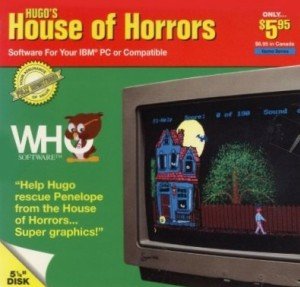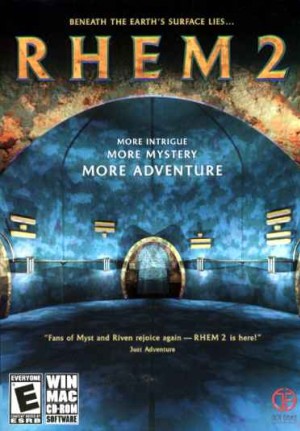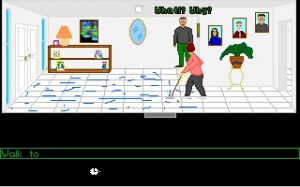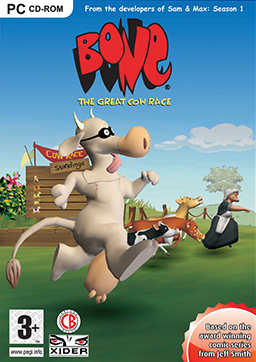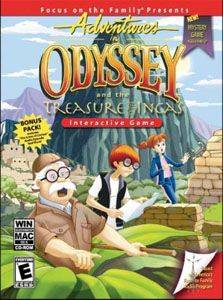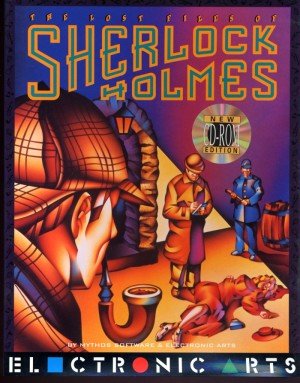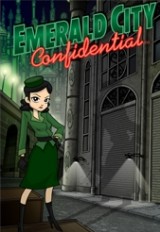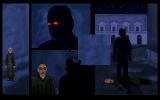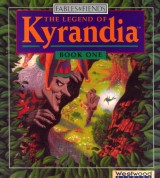Review for Hugo’s House of Horrors
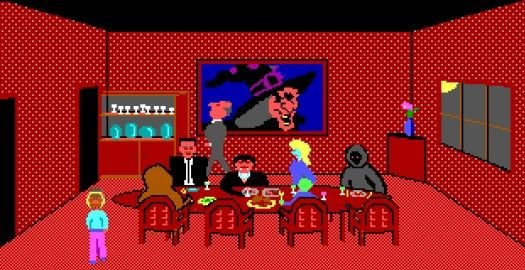
Independent developers have achieved modest but consistent success in the adventure genre in recent years, yet this is by no means a new occurrence, as even a distant twenty years ago there were indies churning out adventures. Back before technology really took precedence, games could be developed in mere weeks as opposed to several years, and instead of being created by large teams, even the most popular game could be made by a few select contributors, or often enough just one. This was the case for Hugo’s House of Horrors, released in 1990 and designed by a single man named David Gray. The game places you in control of the titular protagonist as he looks for his girlfriend Penelope, who hasn’t been seen since she went babysitting at the local spooky mansion. The premise bears many similarities to Maniac Mansion, though this is apparently strictly coincidence, as Gray claims he’d never played the LucasArts classic.
The first of three Hugo adventures has little in the way of character and story progression, primarily because there isn’t much dialogue. The few lines present typically describe a room for the sake of solving a puzzle or finding an additional inventory item. Even the puzzle-related script offers little to no explanation of why exactly you are in your current predicament, from bizarre characters wanting to perform experiments on you (never having seen or spoken to you before) to strange old men testing you with trivia questions that have no relevance to anything before you can progress further. All that is known about the story is a brief introduction provided in the help screen, which is certainly not the ideal location. It would have been better to offer a proper introduction to the characters and a continued sense of urgency in saving Penelope, if only to emphasise Hugo’s feelings towards her and the importance of the task at hand.
The adventure actually begins with Hugo standing outside of the mansion, eagerly looking for a way in, but you spend the majority of your time inside searching for hints to his girlfriend's whereabouts. In the house you will find familiar horror personalities such as Dracula, Frankenstein and the wolfman, but they are contentedly enjoying a meal in the dining room, ignoring your activities. The true terror of the game (limited though it is) comes from other characters like a crazed scientist, a man eating bats and a ravenous dog. There is very little interaction with these characters, as the game lets you know to keep your distance through their innate desire to run at you whenever you go near.
Keeping clear of trouble if you can, you progress through the house by solving simple puzzles using very basic adventure instinct, such as knowing the candle obtained in one room will have relevance in a dark room to come. Many of these puzzles are extremely easy and often only require you to perform obvious tasks like opening a closed closet or lighting up a dark shed in order to locate more items. On the whole this process works fine, but a few of the puzzles are so vague and arbitrary, with so little in the way of hints or direction, that reaching the correct conclusion can be down to nothing but guesswork. One example has you placed in front of a locked door in a box room with nothing but a few boulders present. Trying to open the door with every inventory item provides no feedback, and there is no indication at all that there is another room accessible by simply walking Hugo behind one of the far boulders that appears graphically impassable.
Scenarios like this can be frustrating in their own right, but it’s far more annoying when a lack of feedback ends the adventure altogether. At several points it is very possible, and easy, to die at the hands of many of the mansion’s characters. Dying leaves you with no choice but to reload a previous save (assuming you’ve done so, as there is no auto-save feature), and as these moments are typically sprung on you with no prior warning, it is bound to happen at least once.
While hint systems are becoming more popular today, there is no such option here, so when encountering a puzzle that has no logical solution or any in-game clue at all, you may have no choice but to get external help to prevent certain frustration. I like to keep free of guides, but a particular point in the game requires you to answer the question: ‘What is the name of Roy Rogers’ dog?’... a totally irrelevant question that I would be stuck upon for all eternity, given that there are no hints anywhere to be found. I’d apologize for the spoiler, but if you plan to play, you’ll thank me later. Whilst this type of test only occurs once in the game, it includes a handful of similarly random trivia questions that you either know already or don’t, providing no assistance within the game itself for the latter.
Being comparable to a progressive title like Maniac Mansion was unfortunate for Hugo’s House of Horrors, as the gameplay mechanics were functional but several years out of date right from the outset, noticeably inferior to the impressive SCUMM advancements. Hugo has you moving the protagonist around using the keyboard arrow keys, and controlling his actions by typing in commands. This isn’t a problem on its own, but often the puzzle-solving challenge comes not from clever design but rather the frustration of trying to find words the parser will understand. Large gaps in the game’s word recognition can result in using twenty words before finding the sole solution the game wants you to use. You might think that fixing a hole with a rubber bung should work with ‘fix / repair / use bung / fill hole’, but these had no effect, and it wasn’t until I ‘plugged’ the bung into place that the problem was solved.
Outside of these manageable annoyances, the game also suffers from possible dead ends, and if you’re extremely unlucky like myself, you can find yourself unable to continue without reverting to an old save (thank the skies for anytime save and load states) or restarting from scratch. Such pitfalls can be as simple as failing to solve puzzles in the order desired or missing a cue to act and never receiving it again. My greatest frustration came after neglecting to obtain an item when Hugo was temporarily shrunken in size. When trying to acquire it once he was large again, I somehow became stuck in the game’s environment, completely unable to free myself with any amount of keyboard mashing.
Whilst Hugo is not the prettiest game by any stretch (nor was it two decades ago), it does still hold a nostalgic charm that is reminiscent of early Sierra and LucasArts games. You can practically count the pixels on screen at any given time and the colour pallet is rather limited, but each room effectively displays its desired personality, be it the brickwork and cracked walls of the neglected garage or the eerie entrance hallway that is host to many unwelcoming portraits. These details, whilst slight, help provide a unique flavour everywhere you go. The game doesn’t fare quite as well in the audio department. It starts well enough, as you are welcomed with a fantastically effervescent chiptune, but this is unfortunately one of the few the game possesses. In fact, the game has so little music or sound effects, several times I checked just to ensure the audio was still enabled. Occasionally a new track surprised me out of nowhere, then ended just as quickly, followed by nothing but more silence.
The original version of the Hugo’s House of Horrors is available as legal shareware, meaning it can be downloaded for the costly price of nothing. That’s a good thing, as it only offers around an hour of play, not counting any dead ends or excessive time lost to unanswerable questions, wicked puzzle solutions or nasty bugs. Whilst the game may be graphically underwhelming and lack the polish found even in the competition of its day, free is free, and this adventure is certainly something to keep you occupied for at least a short while. Anyone interested in giving the game a try is advised to make use of DOSBox, which fully supports the game and allows it to run as intended on any modern computer. Without DOSBox, I was completely unable to get the game to start in the latest versions of Windows 7. There is also another option for those happy to part with a little bit of money, as the game has been reworked with point-and-click controls and a modernised Windows interface, released as a trilogy along with its two sequels directly from the developer.
In my childhood, it was difficult to find a PC magazine without this game being mentioned in the shareware section of the demo disc. Now twenty years after release, for those who have never tried a Hugo game before, there is little reason to do so unless strictly for curiosity or to relive fond memories of older times. Still, whilst Hugo’s House of Horrors was never groundbreaking and can’t be considered an enduring classic by any means, it does hold a nostalgic charm of adventure games past, from an era in which anyone could contribute with moderate success.
WHERE CAN I DOWNLOAD Hugo’s House of Horrors
Hugo’s House of Horrors is available at:
We get a small commission from any game you buy through these links (except Steam).Our Verdict:
Hugo’s first adventure was an impressive achievement for a sole individual, but it offers only a shallow storyline and is spoiled by troublesome puzzles and bugs in its hour or so of play time.
You don't want to miss these articles
Adventure Gamers Community
Community reviews for more Adventure Games (randomly selected)
Review of Ben Jordan: Paranormal Investigator - Case 7: The Cardinal Sins
Rating by Niclas (Nov 6, 2012)
Review of Ben Jordan: Paranormal Investigator - Case 7: The Cardinal Sins
Rating by Niclas (Nov 6, 2012)


